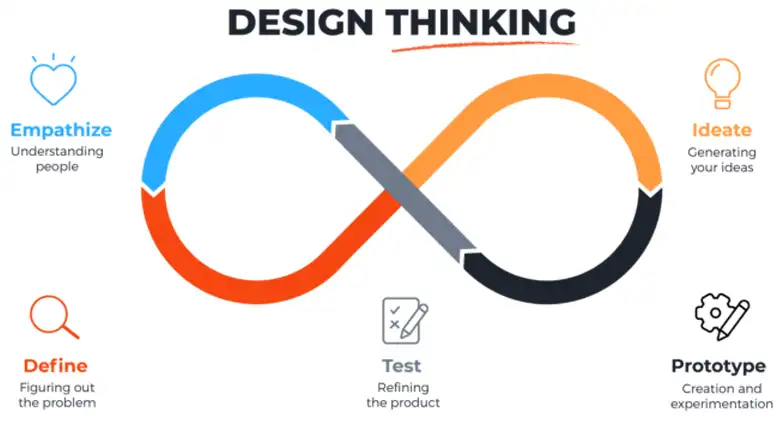Design thinking is a user-centric problem-solving method centred around the use of empathy. Read this guide to understand how applying design thinking can lead to an empathetic design process and improve design outcomes.
Design thinking is a strategy, an iterative approach to viewing and solving a problem by digging deeper into the matter. This means breaking down a problem by re-looking at what you already know and finding solutions to the complex, unresolved parts. While doing so, design thinking places great emphasis on the need to use empathy – to be deeply considerate of user experiences and feelings, and to try to understand the user’s needs without assuming outcomes – since this leads to better solutions.
Empathy is the ability to understand and appreciate the feelings and experiences of others (Oxford Languages). The design thinking mindset uses empathy to question one’s understanding, as well as restrictive or biased lines of thought. This gives one deeper insight into the user’s pain points and helps tackle them holistically. The application of empathy eventually helps design solutions, products/services and spaces – that resonate with users by connecting with their true needs.
In this article, we will explore how the application of design thinking fosters empathy in the design process, why empathy is a crucial component of design, and how you can become a more empathetic designer with the help of design thinking.
Contents:
- What is empathy in design thinking, and why is it important?
- The design thinking process
- 6 ways design thinking leads to more empathetic designs
- Implementing empathy-driven design thinking
- Final thoughts
So, without further ado, let’s get started!
1. What Is Empathy in Design Thinking and Why Is It Important?
When humans are designing for humans, it is easy to assume that empathy will naturally, or almost automatically, be applied. However, that is seldom the case, hence it is vital to understand what role this ability plays in the design thinking process and how to harness it to produce superior design outcomes. This is what the next two sections will explore.
What is Empathy in Design Thinking?
Empathy is the first step of the design thinking process. Empathy in design thinking is the ability to comprehend, appreciate, and understand the feelings, needs, and perspectives of the people you are designing for – your users. When you tackle a design problem with empathy, you may identify issues that are difficult to articulate or may not even be in the user’s mind. You need to embrace empathy in your actions to understand how the user feels in a particular environment.
During the empathy stage of the process, your primary focus is to observe individuals and their behaviours and gather as many experiences as you can so that you can lay the groundwork for your project. As a UX designer, it is important to develop a profound understanding of your users and the specific challenges that your product or service is aiming to solve.
While designing interiors, does removing an internal wall and opening up a space evoke a feeling of comfort, or does it overwhelm the user? What colours and lighting conditions lift their moods?
Think about how a user feels moving from the home screen to a checkout page in an e-commerce app. Is the process intuitive, or does it leave them frustrated?
How can a logo design promoting environmental conservation effectively convey a sense of urgency, sadness about the current state of the planet and hope for a better future while also inspiring viewers to take action by connecting with their emotions?
These are all examples of how approaching a design problem with empathy can enable you to strategically identify the key challenges that a user is facing, which is the first step towards ensuring that you are able to design an effective solution.

Why is Empathy Important to the Design Thinking Process?
Empathy is the foundational principle and first stage of the design thinking process, because it recognises that to create effective solutions, you must first deeply understand the people that you’re designing for.
In the design thinking process, empathy ensures that the solutions you create genuinely resonate with the real needs and emotions of the users. During the “empathise” stage, you converse with the users, observe their behaviours, and understand them on an emotional level. This results in suspending your personal point of view and shifts the focus entirely to the user. The result is a solution that caters to every need of the user and has a larger chance at success in the market it aims to compete in.
2. Design Thinking Process
The design thinking process comprises five steps that are followed in an iterative, non-linear manner in order to arrive at a user-centric, innovative and effective solution to problems. Empathising (or the application of empathy) is both the first stage and the backbone of this process.

Source – Browser Stack
Here’s an overview of the entire process.
- Empathy – Understanding the user’s needs, behaviours, dislikes and preferences, and connecting with them emotionally.
- Define – Leveraging the insights garnered from employing empathy to clearly define the problem that the process will be trying to solve.
- Ideate – Drawing from all insights to brainstorm, generate ideas (including out-of-the-box and unconventional ones), and create personalised mood boards displaying potential outcomes for the solution.
- Prototype – Creating tangible representations of the design solution – from basic sketches to detailed wireframes – to use for testing and further refinement.
- Test – Evaluating your design, getting feedback, and working on iterations.
For a detailed understanding of these pointers, consider reading our Complete Guide to Design Thinking Process.
3. 6 Ways Design Thinking And Empathy Lead to Better Designs

Now that you’ve had a walkthrough of empathy and the design thinking process, let’s delve into why the application of these during your design process is likely to lead to better solutions, products, and services.
By Prioritising User Experience
One of the central principles of design thinking is the concept of user-centred design. This approach highlights the significance of viewing the world through the user’s eyes to gain an understanding of their decisions, challenges, and pain points. By actively observing and empathising with the users, you can create designs that are customised to their unique needs and wants.
How to Use This to Your Advantage
There are a variety of methods to understand the user’s perspective and prioritise the user experience in your design. You can conduct in-depth user interviews to gather insights into their thoughts, emotions, and experiences. This can help uncover hidden wants and preferences.
You could also consider Usability Testing. This involves observing users in their natural environment. Knowing how they feel, what they like and what puts them off gives invaluable insights into their behaviours and moods when using the product/service in question. This understanding is often the foundation upon which innovative and human-centric designs are built.
By Promoting Empathetic Problem Framing
Effective design begins with identifying the correct problems to solve. Being driven by empathy at this stage allows you to frame problems that genuinely reflect the user’s perspectives and needs. Empathetic problem framing involves challenging preconceived notions and assumptions, and opening yourself up to fresh and diverse perspectives.
How to Use This to Your Advantage
Actively listen to users and pay attention to their experiences and pain points. By doing so, you can frame/reframe problems in a way that addresses the root cause, leading to more innovative, impactful and user-friendly solutions.
By Encouraging Storytelling in Your Communication
Storytelling is a powerful tool for conveying empathy to various stakeholders all at once. That is why, if you’re applying empathy and design thinking to your design process, storytelling will become a key component of your communication. And since we are all made up of stories, this is almost certain to improve the resonance of your design outcomes with your audience.
How to Use This to Your Advantage
User-centric storytelling communicates the user’s experiences and promotes empathy among all stakeholders, aligning them with your mission to create solutions that cater to the user’s needs.
Journey mapping is an effective method to enable you yourself to produce empathetic stories. Journey maps provide a visual depiction of the user’s experience and emotions while they are interacting with a product or a space. These maps help you understand the user’s perspective and often lead you to information that matters the most when designing a solution.

Source – Free Pik
By Promoting Constant Analysis of User Behaviours and Feedback
To refine and improve designs continuously, it is essential to gather and analyse user feedback. It is only through this constant analysis that a solution can be iterated and cater to the ever-changing needs of users. This is an integral part of the design thinking process – it not only maximises the likelihood that your initial design solves user problems but also ensures that future versions/iterations continue to do so.
How to Use This to Your Advantage
When you engage in a conversation with the user, in a user interview or otherwise, practice empathetic listening. Focus on the emotional undertones of the user’s experience, instead of focusing on factual information. This depth of understanding will help you in connecting with the user on a more profound level and will be helpful in testing your solution against emotional insights.
Also, be sure to try to seek ongoing feedback from users, eg. through quick feedback forms/surveys integrated into a digital product or application. And then analyse this data to refine your product on an ongoing basis.
By Fostering Interdisciplinary Collaboration
The implementation of design thinking often requires collaboration among individuals with diverse viewpoints. This improves the team’s ability to empathise with a broad range of user experiences and users and users and contributes to creating design solutions that resonate with the widest possible audience.
If the individuals are from different backgrounds/disciplines, then they bring in cross-functional expertise, offering knowledge and skills that are beyond the capacity of teams from an individual discipline. Besides, the diversity that the application of design thinking necessitates also ensures cultural sensitivity. This often translates into understanding and empathising with users from different cultural backgrounds and leads to more inclusive and meaningful solutions.
How to Use This to Your Advantage
When forming your design team, bring together individuals from different backgrounds, since they will bring unique perspectives that may reveal unexplored aspects of your user’s experience. Use this information to challenge any assumptions that might be holding you back or introducing bias into your design. Interdisciplinary collaboration will also provide you with a diverse group of users to test your solution with, as well as create scope for further iteration.
By Approaching Failure as a Learning Opportunity
Design thinking encourages a mindset of learning from failures rather than being threatened by them. This mindset aligns with empathy, as it softens the blow of setbacks and keeps the focus on user needs. Embracing failure ensures that you remain committed to delivering empathetic solutions even in the face of setbacks.
How to Use This to Your Advantage
Learn from user feedback. When a design doesn’t meet user expectations, you must empathise with the user’s disappointment as well as your own, instead of being frustrated. Try to see this as an opportunity to learn from your mistakes and improve your design.
An empathetic mindset encourages resilience. You can use empathy to understand that not every solution will work perfectly in the first attempt. Embrace iterative prototyping and focus on refining prototypes based on user feedback.

Source – Free Pik
4. What to Keep in Mind to Create Empathetic Designs: A Recap
Now that you’re hopefully convinced that applying empathy and design thinking to your design process will improve your outcomes, let us reiterate how exactly you can do so. Consider this a recap of what we’ve shared in the “How to Use This to Your Advantage” sub-sections above, so that you have all the pointers handy in one place.
- Practice empathetic listening
- Ask open-ended questions, to create a judgment-free space and encourage users to share their experiences and feelings
- Look for diverse user perspectives, by including a broad spectrum of participants in your interviews
- Create a design team with diverse skills and backgrounds
- Create an environment where team members freely share their unique perspectives
- Use elements of visual storytelling, such as empathy maps and mood boards, during the design process, to create a comprehensive understanding of the user’s experience in your team
- Create user personas that embody the challenges and emotions of your users
- Keep users at the centre of every design decision
- Actively use empathy, by ensuring that all your solutions are in sync with the user’s emotions, feelings, and needs
- Craft enticing narratives through stories, highlight your users’ journeys, highs and lows, pain points and moments of happiness
- Integrate user research and analysis into your approach
- Get feedback from users, so that you can identify and nip issues in the bud, and leverage insights for future iterations
5. Final Thoughts
We hope that through this article, we’ve helped you uncover the diverse facets of empathy in design thinking and its profound impact on design outcomes, and gone some way to inspiring you to become a more empathetic designer.
As you embark on your journey of incorporating empathy-driven design thinking into your work, keep in mind that it isn’t a one-time check box to be ticked. It is an ongoing commitment to understanding and responding to the evolving needs of your users. Practice empathy at every step, and you will find yourself creating solutions that effectively address your user’s changing challenges, leading to more meaningful and human-centred designs throughout your design journey.
For practical guidance, we recommend taking a look at different case studies and projects. The Callisto Reader’s Cafe Project by AND learner Aromal Jose Baby could serve as a great starting point for understanding the practical aspects of implementing empathy in the design process.
6. Next Steps
We hope this guide on how design thinking fosters empathy has given you a better understanding of how this exciting discipline can benefit your design process.
Since user experience design heavily applies design thinking principles, here are some of the resources you can consider if you intend to pursue the field:
- Watch this session by Shiva Viswanathan, Design Head of Ogilvy Pennywise, and Naman Singh, Product Experience Designer at RED.
- Talk to a course advisor to discuss how you can transform your career with one of our courses.
- Pursue our UX UI Design courses – all courses are taught through live, interactive classes by industry experts, and some even offer a Job Guarantee.
- Take advantage of the scholarship and funding options that come with our courses to overcome any financial hurdle on the path of your career transformation.
Note: All information and/or data from external sources is believed to be accurate as of the date of publication.









